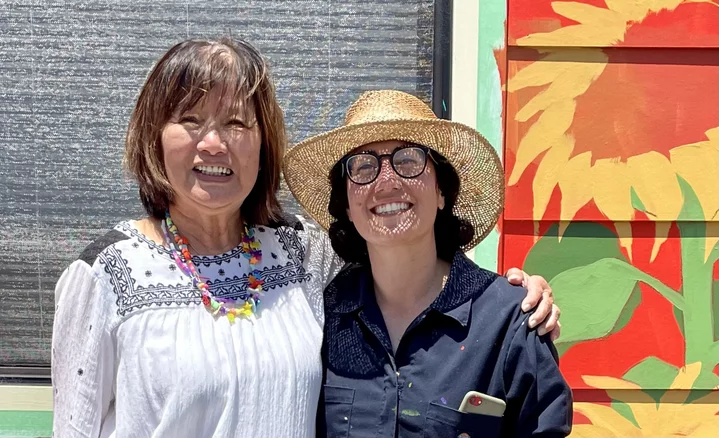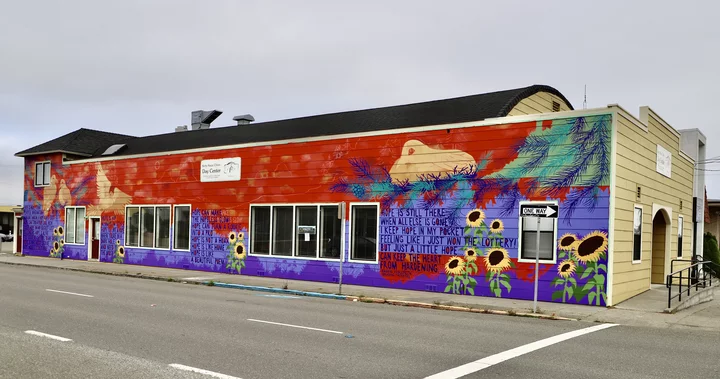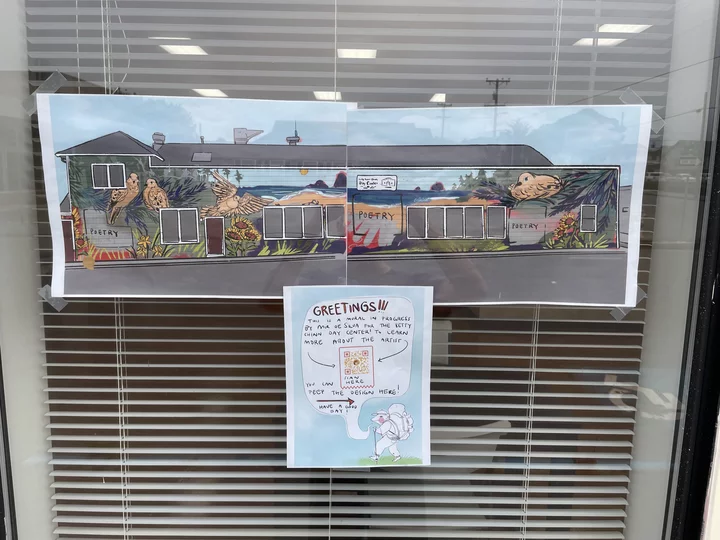Humanitarian hero Betty Kwan Chinn (left) with artist Mir de Silva. | Photo by Ryan Burns.
###
When Betty Kwan Chinn first saw the design of the colorful new mural being painted along an exterior wall of the Eureka homeless center that bears her name, the local humanitarian hero was stunned: The imagery, which includes mourning doves, sunflowers and a coastal landscape interspersed with a playful poem about hope, struck Chinn as a depiction of her own life story.
She remembers turning to the artist behind the mural, 33-year-old Mir de Silva, with a question.
“I asked her, ‘Do you know me? Where’d you get my story?’” Chinn recalled.
De Silva didn’t know Chinn’s harrowing life story — not the early part, anyway. She just knew of Chinn’s tireless work with the homeless.
Raised in a military family, de Silva moved to Humboldt County eight years ago, attending College of the Redwoods and Humboldt State University, graduating with degrees in art education and studio art.
“I moved here in 2015, and I’ve heard every myth and tale of her, you know, taking the shoes off her feet while driving around in the Hoopa area to provide shoes for the homeless — all the stories, and I was like, you know, she’s cool,” de Silva said.
Standing with de Silva in front of the partially painted mural earlier this week, Chinn explained how she sees her own story in its images.
“When I was really young, I wanted to die,” she began.
To understand how she sees such darkness in this cheerful mural, you’ll need a bit of context.
Chinn was just seven years old when she was turned out of her family’s home in China’s Guangdong province during Mao Zedong’s Cultural Revolution. North Coast Journal News Editor Thadeus Greenson described this period of her life in a 2016 profile:
Targeted because of her parents’ wealth and Christian beliefs, Chinn spent years homeless on the streets. Alone, with her mother jailed and her siblings hauled off to labor camps, she found refuge in a garbage dump and foraged for food. Mao’s Red Guard forbade Chinn from speaking to people and hung a wooden sign around her neck with wire that read “child of the devil.” She was ostracized and beaten, and years later would have to relearn how to speak. She lived like this for four years until — after having seen family members tortured and killed — Chinn and three of her siblings fled, hiking hundreds of miles before swimming across the Pearl River Delta to freedom in Hong Kong.
The story Chinn sees in this new mural is not that one, exactly, but rather the hope that paradoxically sprung from such a grim existence, a period so bleak that, at her lowest point, she wanted to die. Until …
“A little tiny bird, he scratched my face, and when I saw him [fly away] I said, ‘I have a dream, and someday I’m going to fly out of here. I’m going to free myself,’” Chinn said. “And then I see the bird there!” She gestured up at the golden-hued mourning dove half-painted on the wall behind her, its wings spread in flight.
She finds the mural’s sunflowers another potent image, their dish-shaped heads a source of inspiration even when the sun itself is not shining. And the sketched-in coastal scene reminds her of that long swim to freedom across the Pearl River Delta.
“It’s really, really the story of my life, and every time I look at that bird it really gives me a lot of encouragement,” Chinn said, her face beaming with happiness.
“And then they have this poem in here. Even better!”
The poem, composed in spoken word style by de Silva’s neighbor, Rashad Hedgepeth, is an irreverent paean to hope. (The word appears nearly 20 times in the short composition.)
”The hope they talk about, this is real,” Chinn said. “You have no idea how many people stop by and write it down or take a picture. It’s beautiful.” Gesturing toward de Silva, she added, “She’s really wonderful. Good artist.”
The mural is being painted along the southern wall of the Betty Kwan Chinn Day Center, 133 Seventh Street in Eureka. | Photo by Andrew Goff.
###
In another (perhaps less significant) coincidence, de Silva is painting her mural around the same time as the latest Eureka Street Art Festival, though this project is independent of that endeavor. Chinn explained that it’s being entirely financed by one generous donor, who wants to remain anonymous.
“I didn’t know that!” de Silva exclaimed.
She (de Silva) initially sought to get the project funded through a round of 2022 grants administered by the Humboldt County Association of Governments, but it was an awkward fit — the agency asked specifically for projects to convey the hardships created by the local housing shortage — and the opportunity passed.
But the board of the nonprofit Betty Kwan Chinn Homeless Foundation still wanted a mural, and its members signed off on de Silva’s design, though it took her a while to come up with one.
“I was really intimidated when I saw the size of the wall,” she said.
In search of a starting point, she asked Hedgepeth to compose a poem about hope and then used his words as inspiration.
“I was hanging onto the idea of a bird in flight being a very hopeful image and going across a lot of denominations — spiritual people, environmentalists … I feel like the bird flying is a really universal symbol,” de Silva said.
White doves struck her as too cheesy, but she feels strongly about showcasing native flora and fauna in her murals, and since our region has its share of mourning doves, they fit the bill.
But the prospect of filling such a large wall was still daunting.
“I had a lot of sleepless nights,” she said. Thankfully, she was able to use the 11-inch planks of the building’s siding as a grid on which she could map out her design.
De Silva taped a printed depiction of her mural design on the inside of a window on the wall she’s painting.
###
“So I was able to freehand this with chalk,” she said of the mural. “It makes it so much easier than me trying to get a projector. … It’s a lot more loosey goosey, which you’d think would make it more intimidating, but it actually helped me to make this kind of a fun, meditative process instead of me being hell-bent on it being perfect.”
De Silva, like Chinn, hopes the mural brightens up this generally drab stretch of the city and inspires the people who come across it.
”I know that a lot of people consider the homeless problem an aesthetic issue,” de Silva said, noting that Chinn tends to focus her efforts in parts of the city that some residents deliberately avoid. “And so that’s where artists come in and try to make that [area] a little bit more positive. I love what she’s doing. I think drawing positive attention to what she’s doing is important.”




CLICK TO MANAGE